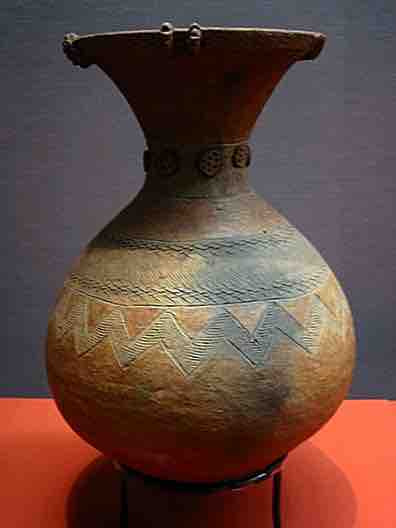Overview: The Yayoi People
The Yayoi period is an Iron Age era in the history of Japan traditionally dated 300 BCE to 300 CE. It is named after the neighborhood of Tokyo where archaeologists first uncovered artifacts and features from that era. Distinguishing characteristics of the Yayoi period include the appearance of new Yayoi pottery styles, the start of an intensive rice agriculture in paddy fields, and a hierarchical social class structure. Techniques in metallurgy based on the use of bronze and iron were also introduced to Japan in this period.
The Yayoi followed the Jōmon period (13,000–400 BCE), and Yayoi culture flourished in a geographic area from southern Kyūshū to northern Honshū. Archaeological evidence supports the idea that during this time, an influx of farmers from the Asian continent to Japan (known now as the Yayoi people) absorbed or overwhelmed the native hunter-gatherer population. Chinese expansion under the Qin (221-206 BCE) and Han (206-220 CE) Dynasties is said to have been one of the primary impetuses for migrations to the Japanese archipelago.
Influence on Art
These people brought with them their knowledge of wetland rice cultivation, the manufacture of copper weapons and bronze bells (dōtaku), and wheel-thrown, kiln-fired ceramics. Along with introducing bronze casting and other technologies into the islands, the Yayoi people brought cultural influences from China and Korea. Artifacts brought to the islands at this time had a powerful effect upon the development of Japanese art by presenting objects to imitate and copy, such as bronze mirrors and swords in the Chinese and Korean styles.
Yayoi pottery was simply decorated and is thought to have been produced on a potter's wheel, as opposed to poetry from the earlier Jōmon period, which was produced by hand. Pottery from the Yayoi period also tends to be smoother than that of the Jōmon period, and it more frequently features decorations made with sticks or combs, rather than rope. Yayoi pottery, burial mounds, and food preservation have been discovered to be very similar to the pottery of southern Korea, suggesting the Yayoi people originated in the Korean peninsula; some pieces of Yayoi pottery also clearly show the influence of Jōmon ceramics.

Yayoi art
A jar from the Yayoi period (1st - 3rd century CE)
Chinese influence on the Yayoi culture can be seen in the bronze and copper weapons and other objects of the Yayoi people, as well as irrigated paddy rice cultivation. Three major symbols of Yayoi culture include the bronze mirror, the bronze sword, and the royal seal stone. Yayoi craft specialists also made bronze ceremonial bells, known as dōtaku. By the 1st century CE, Yayoi farmers began using iron agricultural tools and weapons.
A Yayoi period dōtaku bell, 3rd century CE
Yayoi craft specialists made bronze ceremonial bells, known as dōtaku.